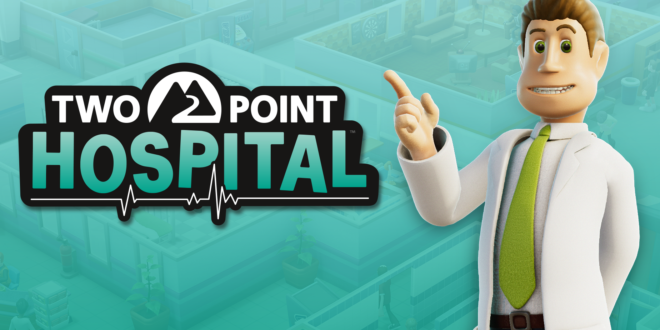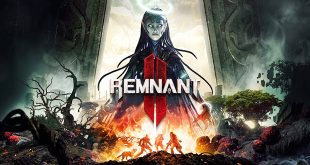Talking to Two Point Studios’ three co-founders, it feels like there are two ghosts watching us during the entire conversation. Not scary ghosts, no. Two benevolent ghosts with a reassuring, proud smile on their faces. Their names are Lionhead and Bullfrog.
Because the story of how Two Point Hospital was made is also a story about how Theme Hospital was made by Bullfrog Productions 22 years ago and a story that’s deeply intertwined with Lionhead’s closure in 2016.
Peter Molyneux founded Bullfrog in 1987 – he was joined by Gary Carr in 1989 and by Mark Webley in 1992. Both Carr and Webley worked on Theme Hospital as project leaders, with the game meeting huge success. In 1997 Webley left Bullfrog and co-founded Lionhead with Molyneux. Carr ended up joining them in 2003.
Fast forward to December 2014 and Ben Hymers enters the game – having worked at Rare and Creative Assembly, he joined Lionhead as creative engineer. That final move set events in motion for the three of them – Gary Carr, Ben Hymers, Mark Webley – to create Two Point Studios.

“The idea [for Two Point Hospital] probably stems back from many years ago when Gary and I worked together at Bullfrog – we worked on a few games together but we really enjoyed Theme Hospital,” Mark Webley starts explaining. “We had a bunch of ideas like ‘Oh, it’d be cool after Theme Hospital to do Theme Prison or Theme Resort’ but it just never happened. I left and Gary left – Gary did Mucky Foot and I came up with Lionhead. We kept crossing socially and then we were together at Lionhead and we just kept saying; ‘Oh, we should do that one day’.”
Ben Hymers continues: “I don’t have nearly as much experience as these guys, I was never part of all of that early Bullfrog stuff but it’s because I was only 12 years old,” he laughs. “But I loved the sound of it and I joined a small team at Lionhead that Gary was leading – an incubation team doing prototype work. So we worked together doing some sim-like games and I was struck with awe working with Gary, as he’d done the art on Theme Hospital. From there we sort of hit it off I guess. Gary thought it’d be nice to start something again.”

By that point, Lionhead had been acquired by Microsoft. Gary Carr takes over: “We tried to hit it off with Microsoft but Fable Legends was just so all consuming and it was really difficult to convince Microsoft at the time to make them think about other things Lionhead used to be good at doing.
“My incubation team just wasn’t looking likely to get a project into production. [Fable Legends] was taking up a lot of the resources and it was looking less and less likely to happen. So I was out of the door pretty much and then Ben…” He turns to Hymers before continuing: “You weren’t happy, you went to do incubation and you thought you were going to be out of the door.” Hymers smiles and nods.
Carr and Hymers started prototyping ideas – that’s when Carr decided to talk to Webley about it all, who continues the story: “Gary and Ben’s idea was: it’s 20-odds years since Theme Hospital, there are still people who love that game and it would be cool to bring it up to date as a kick-off for a studio.

“There was always a clear vision of these little sim games that we wanted to make, harking back to the culture of Bullfrog which was a lot of small teams, a lot of easy communication. We didn’t have a designer back then, because we designed the game, and we didn’t have producers because they hadn’t been invented yet,” Webley laughs.
Carr continues: “So that’s when we got together. But then the next challenge was: how do two 50-years-old guys and a 30-year-old guy start a company?”
THERE’S ALWAYS LUCK
It’s now March 2016 – the games industry is in shock as Microsoft announces it has “decided to cease development on Fable Legends, and [is] in discussions with employees about the proposed closure of Lionhead Studios in the UK.”
Carr, Hymers and Webley meanwhile were lucky enough to have left the studio before its sad fate started to unravel and were already going full steam ahead with their project of launching a new studio.
“At this point, a lot of people were doing crowdfunding, Kickstarters and that was a new world, at least certainly to me and Mark,” Carr says.
Hymers adds: “That’s the kind of thing I was suggesting early on because at the time there were quite a lot of big successful Kickstarters, usually for retro games and reboots or remakes. It seems like a very popular thing to do.”
The three associates started discussing it with other industry figures – Gavin Price at Playtonic, who had just successfully crowdfunded Yooka-Laylee, and Team17 boss Debbie Bestwick for instance. They suggested that the golden age of crowdfunding was maybe already over.

Enter Sega, just as Carr, Hymers and Webley were now looking for a publisher for their Theme Hospital spiritual successor.
“To be honest we didn’t think Sega would be interested,” Webley says, before Hymers adds: “We ended up getting in touch [with Sega] because when I left Lionhead I went to work at Playsport on Motorsport Manager – Playsport being signed by Sega. And it’s Christian [West, founder] there who suggested it would be a good idea for us to talk to Sega. He put us in contact and as it happens they were already having discussions about the kind of games they wanted to publish.”
Webley continues: “We went in, we did our presentation and Dean Trotman [then commercial director at Sega] said: ‘You won’t believe this, a week ago we had a meeting where we said: wouldn’t it be great to have a game like Theme Park in our books?’,” he laughs before adding that they “got lucky” really.
Carr adds: “There’s always luck, we’ve all made games in the past which have been just as much effort and love and passion and haven’t done as well. This is the reality of development. There is an element of luck.”
And that’s how Two Point Studios was born.
THE SILLY LITTLE THINGS
For what was going to be Two Point Hospital – which ultimately launched in August 2018 – a lot of the development process was fed by very informed decisions. Two of the three founders had two decades of experience after all and a lot of Theme Hospital translates over to Two Point Hospital. And, by the way, if you’re wondering why it’s not called Theme Hospital 2, it’s because EA owns that license.
“It was very Bullfrog, the idea of having humour in the game, breadth and depth. And certainly a lot of the latter Bullfrog games were very accessible,” Webley says. “I think taking a subject matter like running a hospital, which is a stupid idea, and turning it into something which was good fun to play, which had a longevity to it – we learnt a lot from that,” he smiles.
Ben Hymers could bring another very valuable opinion to the table: his experience of Theme Hospital as a player.
“We had Edge Magazine coming round and literally ignoring us because we were horribly old fashioned.”
“For me as a player, the things that shine through and that stick in my memory are just the little details that make [Theme Hospital] this fun, polished game,” Hymers says. “Because I wasn’t quite old enough to appreciate the depth of the simulation, it’s all about the silly little things like people knocking on the doors before they go through them and, at the time I didn’t appreciate how complicated it was, but the stuff that Gary and Mark have done with making sure props line up with hands and people actually sit in chairs and things like that. It sounds stupid but it’s all these little things that really makes it feel like a living little world.”
And there’s a good reason why Bullfrog was so details-oriented back then, Carr explains: “We had absolutely nothing to show off about,” he laughs as Webley mentions that they “were doing pixel art when everyone was moving over to 3D.”
Carr adds: “We had Edge Magazine coming round and literally ignoring us because we were horribly old fashioned and doing things that were very last generation. So we were trying to show off in any way we possibly could with our limited skills and that was trying to make everything super detailed so the small personalities, opening doors, closing doors, scratching heads, sitting down, little bits of interaction. We were trying to punch above our weight in character. Because the subject matter was hospital and illness we needed to make it feel more palatable so we did that with charm and comedy and that’s how we sold what was, at that time, a rather unusual subject matter.”

And the team made sure Two Point Hospital was developed with the same attention to detail, Hymers continues: “We kept that streak of making things charming but of course using the technology of today to do more interesting things. Back then characters wouldn’t really interact with each other. They would walk straight through each other. But now we have characters that look at each other, do silly things like dance competitions in the hallways. So hopefully we kept that charm but made it more modern.”
Mark Webley and Two Point Studios’ designer Ben Huskins (who worked at Lionhead from the first to the last day of the studio) also came up with the trait system to push that attention to detail further, trying to make the experience unique with every gameplay session.
“If certain personalities meet other personalities they may react completely uniquely,” Carr explains. “So somebody who’s flirtatious may have a completely different reaction to someone who is shy or grumpy. So you can play [Two Point Hospital] for hours and hours and suddenly see a completely unique scene because you’ve never had that situation. The idea has been implemented by the code team into something that makes it feel alive and unique so I’m really proud of that.
“Also, on the art side, we wanted something that wouldn’t date very quickly – if Two Point Hospital is around for even half the time Theme Hospital did, it will have done amazingly well. We wanted to make a style of rendering which didn’t feel like it was technology driven, but more hand crafted. It’s a very claymation looking art style so it feels handmade which is what the first game felt like.”
What was crucial to the entire team was that Two Point Hospital felt innovative and not dated.
“The game feels, to me, quite fresh and of course it has a nostalgic element to it, we’d be lying if we didn’t recognise that, but it does still feel fresh, it feels like it’s a nice face to go back to,” Carr says.
Two Point Studios comprises about 15 people – about half of them are industry veterans while the other half is new blood. Webley explains that this new blood was instrumental in making Two Point Hospital feel original.
“The approach was always going to be more modern, the art style was always going to be up to date, it was always going to be 3D. We’re not just developers, we’re players of games as well,” he adds. “Things like Prison Architect, which is artistically nothing like our game but their approach to market was: get something out there in Early Access and then keep developing. And that’s what we thought we could maybe do. Let’s get something out! Then other games like Cities: Skylines – brilliant game! And you kind of think: ‘There’s some good ideas in there, let’s steal them!’,” he laughs.” So I think we’re just influenced by the games we play as well.”
The three co-founders mention two other examples of how they embraced a more modern approach with Two Point Hospital: the idea of “continued development”, with at the time of writing 11 updates provided to the title, and Steam Workshop support, with Carr saying: “It’s not only adding Steam workshop. We’ve done it in a way that feels like the game UI. We’ve tried to make it feel seamless, so that people who wouldn’t normally use something like Workshop would be encouraged to use it.”
LAYERS ON LAYERS
That leads us to talk about the UI in more details as this is obviously a crucial element of any sim game.
Webley immediately says in a laugh they probably “underestimated just how much work the UI was going to be,” focusing first on getting a playable version of the game out of the door as soon as possible.
He explains: “On Theme Hospital we had a row of icons at the bottom. And this was all done by hand. So first implementation had maybe six icons across the board. And then you kind of realise you need another one. And then you put another icon and then you’re like: ‘Oh, hang on, we need another one!’. We didn’t really know what we wanted.”
On Two Point Hospital as well, the team wasn’t sure that they wanted. But Carr knew what he didn’t want: “A lot of PC games, especially in strategy and simulation, have these very small icons which look incredibly complex. The original Theme Hospital was kind of very easily readable, chunky and accessible UI that didn’t intimidate people. It was kind of the same thing we were trying to do with the gameplay – make people think it’s easy to use and then further down the bottom it gets more and more complex and if people don’t want to do that they can still play the game. If they want to get into all the management and simulation details, they can, they can dig down into the UI. So we had this idea to try and reproduce that. We had loads of people involved – it was possibly the most work the whole team got involved with.”

Webley concludes saying he’s happy how the UI turned out: “The vision certainly was to make [Two Point Hospital] accessible and easy to play. And we always had this idea of: make it accessible but deep. Get to it nice and easy and then put layers of polish on it.”
And the studio is certainly not going to stop there as the game has had great success since launch.
“The big picture for the studio is Two Point County. So we’re building this bigger idea of different subject sims that coexist within a world. But right now we’re enjoying just working on this game because it still feels like we’ve only started it five minutes ago,” Carr laughs.
Finally, there’s another reason to keep working on Two Point Hospital – and that one is much more personal.
“We were happiest making [Theme Hospital] – even Ben would talk so fondly about playing the game at the other end of the experience,” Carr says. “We just liked to recreate the fun of being in the industry because as gaming studios get bigger, you get promoted into very boring jobs.
“Mark and I became director-type people. Mark was the founder of Lionhead but I was on the leadership team so we were just spending all our time making performance reviews and making sure we’re not spending too much money – all these kinds of crappy jobs that you do when you get promoted out of the fun stuff. So it was important to try and reinvent a bit of the highlight of our careers and I think we’ve done a reasonably good job at recreating our heyday.
“And I’ve had an absolute blast – two years and I still come into work with a smile on my face, feeling really happy and hopefully it’s the same for everyone and they have fun making this game. And that’s how it should be – what’s the point of making games if it’s not fun?”

 MCV/DEVELOP News, events, research and jobs from the games industry
MCV/DEVELOP News, events, research and jobs from the games industry




